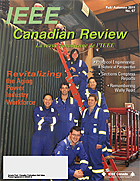|

|
|
IEEE Canadian Review On-line
La revue canadienne de l'IEEE
|
|

|
|
Fall / Automne 2011, No. 67
|
|

|
In English
Editorial
President's report
Regional Coverage: A View from the West
IEEE Canadian Foundation Report
Tribute to Wally Read
Sections Congress 2011 Report
Eng. Management: "Best Of" from the Literature
CCECE-CCGEI 2012
Conferences 2012 |
En français
(en développement)
|
|
 |
|
Feature articles
|
|
Articles de fonds
|
|
|
 |
|
|
|
Title/Titre:
Replenishing the Aging
Work Force in the Power Industry
|
|
Authors/Auteurs:
Daniel Wong1,
Randy Kimura2
1 AltaLink Management Ltd.;
Calgary, Alberta, Canada
2 SUBNET Solutions Inc.;
Calgary, Alberta, Canada
|
|
Abstract:
This paper discusses the program to develop, and more importantly, to attract the interest of the next generation of technical experts. The respective roles of industry and academia are discussed. Replenishing the aging work force is discussed as a four step approach starting with increasing the size of the available work force supply pool by presenting the profession as an appealing career choice. Encourage and support career entry by making the process a seamless transition into the power industry. Effectiveness of the new work force is accelerated through fast tracked training and development. Strong retention programs reduce departures from the industry.
|
Sommaire:
Cet article discute du programme à développer, et d’une manière plus importante, la façon d’attirer l’intérêt de la prochaine génération d’experts techniques. Les rôles respectifs de l’industrie et du milieu universitaire sont discutés. Le comblement de la maind’oeuvre vieillissante est discuté en tant qu’approche en quatre étapes commençant par l’augmentation de la taille du bassin de main-d’oeuvre disponible en présentant la profession comme un choix attrayant de carrière. L’encouragement et le support de ce choix de carrière en facilitant le processus de transition dans l’industrie énergétique. L’efficacité de la nouvelle main-d’oeuvre est accélérée par la formation et le développement rapides. Les programmes de rétention forts réduisent les départs de l’industrie.
|
|
 |
| Communications
|
Communications
|
|
|
Title/Titre:
Protocol Engineering: A Historical Perspective
|
|
Author/Auteur:
Gregor v. Bochmann; University of Ottawa, Ottawa, Ontario, Canada
|
| Abstract:
During the 1970s and ‘80s, the first computer communication networks were designed and implemented in the research and commercial sectors. Many of the protocols developed during that time are still in use today. This paper starts by giving an overview of these developments. Then it concentrates on the development of protocol engineering, that is, the methods for the specification of communication protocols and services, the verification of protocols and their implementation and testing. After personal views of the developments in the 1970s, the basic concepts developed at that time are explained. The standardization of Formal Description Techniques in the 1980s is discussed in the following section. The purpose of the paper is to show the long way we have come and to suggest that many of the basic concepts have not changed too much during these years, although more detailed aspects have evolved and given rise to new technological developments.
|
Sommaire: Le premier réseau de communication informatique fit son apparition au cours des années 70 et 80. Il fut implémenté pour les domaines de la recherche et du secteur commercial. Plusieurs des protocoles développés à ses débuts sont encore utilisés aujourd’hui. Ce document débute par un aperçu de ces développements. Par la suite, il se concentre sur le développement du protocole d’ingénierie, qui est, l’ensemble des méthodes de spécification des protocoles et services de communication, la vérification des protocoles, leur implémentation et les tests. Après plusieurs évaluations des développements effectués durant les années 70, les concepts de base développés à cette époque sont expliqués. La normalisation des techniques de rédaction est abordée dans la section suivante. L’objectif de ce document est de démontrer le progrès réalisé depuis les débuts des réseaux de communication informatiques, d’illustrer certains concepts de base qui ont peu changé et les aspects qui ont évolué afin d’intégrer le développement
technologique.
|
|
 |
Please consider being a sponsor of the Review. Click here for details.
Considérez devenir un commanditaire de la revue. Cliquez ici pour les détails.
|
Last update / 2011-12-02
/ Dernière mise à jour
|



